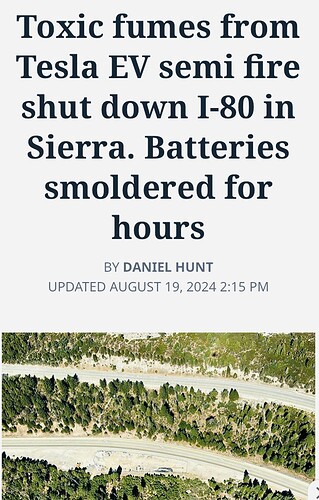These are dangerous but not EV Battery fires.
83 times more likely for a car fire to occur in an ICE vehicle vs EV.
5 times more likely to be hit by lightning in the US than have an EV fire.
EV vehicles have their issues, fires are not one of them (yet).
I think the biggest issue would be suppressing an ev fire, vs a gas or diesel engine fire. Seems to be more difficult or maybe it’s just because we don’t see them as often and don’t know the best way to mitigate it. I am no expert and have no experience with it but maybe some one else can explain better? Maybe technological advances in suppression of ev fires will make it less difficult as we encounter more of these. There is always going to be new things out there that we will have to learn about and train for!
It’s a run away thermal chemical fire. There’s really no stopping them…just containment woth a thermal blanket, thousands of gallons of water ( then eco. Issues with run off) or just watch them burn until the rx is complete.
Lith-X is a product that works, but having to get close enough to be effective is another issue…
The way I understand it, not really a chemical reaction that can be stopped, but more of an electrical/energy discharge issue. Once fire mechanically damages one cell that is in close proximity to another cell, then each adjacent cell is going to “go off” and dump its energy and damage nearby cells whether you like it or not. Resulting in a lot of heat being generated in a concentrated area which leads to continued fire. Also this is happening in a lot of rectangular packages made of metal or plastic stacked closely together. So it sheds water, not like the engine compartment of a car where there are open spaces for water to go in and around the burning material.
One Storage Battery facility fire in Otay is in its third week of burning.
With increased usage of lithium batteries, this problem is going to grow exponentially.
Collection points as per the story open 30 hours a month, weather permitting, no holidays, for a city of 7 million is a very feeble attempt at controlling the problem. When you go to more rural areas and states, more often than not you will not even find a recycling facility much less a
haz-mat recycling facility.
Unintended consequences of creation without the use of foresight. Same thing for styrofoam packing and cups, plastic bottles, and so on.
I remember when milk and soft drinks came in glass containers and were recycled.
EV vehicles are another creation without the foresight or facilities to handle safely and dispose of safely. Have to look at cause and response.
The only “safe” EV’s that I am aware of are golf carts and the local EV cars that were manufactured to use wet cell batteries. They are relatively low speed, local use. Approximately 30 mph.
But the batteries are comparatively far less expensive and easily recyclable. For those who need economical transportation to travel a 5-10 mile radius, may make sense.
It is not the lithium ion batteries burning in trash trucks that is life threatening, its the CNG tank on top of the trash truck that will, and almost has, killed firefighters. The truck explosion in San Pedro/Wilmington is a prime example.
The fire from burning lithium ion battery fires is loaded with heavy metals.
Heavy metals are a “forever chemical” that stays in you forever.
